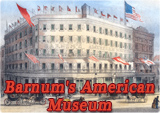
American Museum
The American Museum in New York City was originally established by the Tammany Society in June, 1790, for the purpose of collecting and preserving everything related to the history of America and American production of nature or art. It was the first museum established in the City of New York and the second in the United States.
The name "American Museum" was used in August, 1790, in a petition to the Common Council, stating that: having established an American Museum and having already received several donations, the museum was “destitute of a proper place for depositing the same.” The committee representing the Tammany Society asked for “one of the rooms in the City Hall of this City, for their temporary accommodation". On September 2, the board granted the society “the use of the upper room in the city hall in front of the Library Room whenever the same shall be cleared by the officers of Congress".
In 1791, John Pintard Jr. (1759-1844) was the trustee and secretary of the museum (possibly since the beginning), and Gardner Baker as a keeper. In a letter to Dr. Jeremy Belknap of Boston, dated October 11, 1790, Pintard wrote he had added his Indian Bible to the collection of the "American Museum" (as referred by him). Pintard drafted the constitution of the Tammany Society, was cofounder of the Massachusetts Historical Society and the New-York Historical Society.
In 1793 (at some time between May 27 and October 15), the "Tammany Museum" moved to the old Exchange, on the foot of Broad Street. In October, Bowen added his collection of wax work to the museum. At the time, the contents of the museum also included living animals, birds, snakes, and fishes, preserved animals and birds.
On June 25, 1795, the members of the Tammany Society assigned all their right in the Museum to Gardiner Baker. One of the conditions was "That the same shall forever hereafter continue to be known by the name of the Tammany Museum, ..." At the time, the collection included a bison, an 18-foot yellow snake from South America, a lamb with two-heads, wax figures, pieces of Indian, African, and Chinese cultures and a guillotine with beheaded wax figure. Baker died in September 30, 1798, and the museum was continued by Mrs. Baker. The Exchange building was demolished in 1799 and the museum moved to 222 Greenwich Street.
On May 10, 1800, the museum collection was bought at auction by William I. Waldron. Later, it came into the hands of the artist Edward Savage (1761–1817), who opened the Columbian Gallery of Painting and City Museum in 1802, and hired John Scudder to oversee the museum's collection.
In 1809, Scudder acquired the collection and opened the American Museum in March 1810 at 21 Chatham Street. In July 1817, the Scudder's American Museum moved to the former Alms House building, in the City Hall Park (see on the right). At the time the collection included 80 stuffed animals and over 160 glass cases, with 600 specimens. People in all parts of the country had sent in relics and rare curiosities. Scudder died in August 1821. His son John Scudder, Jr. and his four daughters were too young to take over their father's position. The museum was managed by five trustees, led by attorney Cornelius Bogert, according to the Scudder's will.
On December 24, 1830 the American Museum opened in its five-story new building, on the corner of Broadway and Ann Street. In 1841, Phineas Taylor Barnum (1810–1891) acquired the American Museum and renamed it the Barnum's American Museum. On July 13, 1865, the American Museum was destroyed by fire.
P.T. Barnum opened a New American Museum on September 6, 1865, at 539-41 Broadway, between Spring and Prince Streets, but that also burned down, on March 3, 1868.
|
Copyright © Geographic Guide - Old NYC. Historic Buildings. |
by Jonildo Bacelar
American Museum

1790-1865